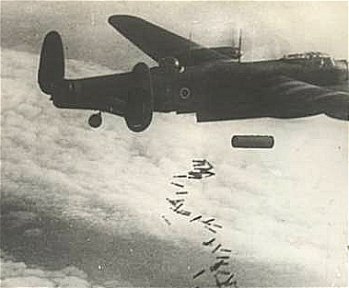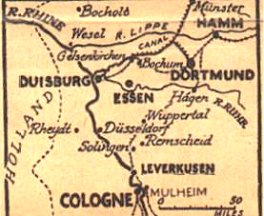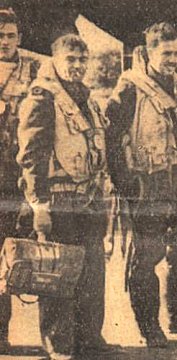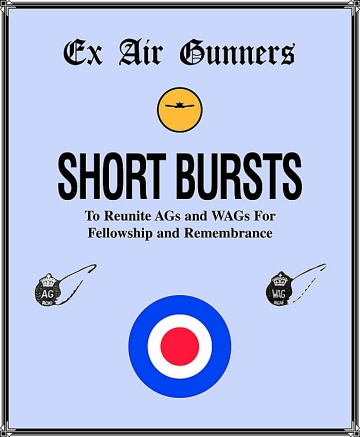
Larry Robinson
AG Association No. 0021
101 Squadron.
Two Trips to Duisbury
Oct. 14 and 15 1944.
I was on both of these trips
in October/44. Man, that is a long time ago!
Our trips were mostly no
problem, some flak, no fighters. On trip two we had to feather our Starboard
outer just before the target. The above picture was taken by William Troughton
a wartime journalist who made both trips from our 101 Squadron at Ludford
Magna. Mr. Troughton caught the 4000 lb. “cookie” and incendiaries perfectly.
Very faintly you can read the aircraft designation SR-B. You can also see
that this aircraft is equipped with two aerials placed just in front of
the Mid Upper Turret. This was to disrupt German fighter Control. We had
an extra WAG whose job it was to pick up German frequencies. He could speak
fluent German and could give the fighters false information. Or, sometimes
just tune a Merlin (one of our engines), onto the frequency.
Our Navigator had to be sharp
as we needed to be over the target at specific times to give all bombers
as much protection as possible.
We usually sent out 22 aircraft
from 101 Squadron.
Daily Express Oct.
16, 1944
I FLEW BACK TO SEE DUISBURG
DIE
By William Troughton
William flew on both raids
on Saturday, and is the first War Correspondent to make a day and night
raid in the same day.

At an RAF Station, 5 a.m.
Sunday
The Medical Officer had just
asked me to take a sleeping tablet – and I’m almost asleep on my feet.
It sounded so silly that I had to laugh.
But the boys who have just
come back from Duisburg are all milling around him with their hair dishevelled
and their eyes heavy with the need for sleep, and they are taking his tablets.
Funnier still, because only seven hours ago we were taking “Wakey-wakey”
tablets from him to ward off sleep.
We were pretty tired then,
for most of us were setting out to bomb Duisburg again for the second time
in 18 hours. Now we are back - and we have left Duisburg dying. We have
dropped more than 10,000 tons, including 500,000 fire bombs on the city
– one ton for every 45 of its inhabitants – delivered in two great
raids of more than 1000 planes each.
Twenty of those planes have
not come back. That was inevitable for Duisburg is still one of the most
heavily defended cities of the Ruhr Valley. But our losses are surprisingly
small, only .9 per cent.
This is what happened
in the two attacks
By Day. Yesterday morning
when we saw at last the great waterways of Duisburg gleaming in the sunshine,
the sky ahead of us was full of the aircraft that were going in with the
first wave. They looked like a cloud of gnats. Behind us hundreds more
were stretched across the sky.
Flying Officer J. Whitwood,
of Norwich, stockily built, fair haired, put on his best guide manner and
said over the intercom, “and there, Bill, on our Port bow, is the great
big ‘Happy Valley’.”
But ahead of us ugly black
smudges of smoke appeared among the gnats and slowly expanded into big,
black blobs. And suddenly a pale blue smoke trail spiralled down from the
cloud of gnats in front.
“Somebody’s got it,” came
some one’s voice over the itercom.
Down in the dock area behind
Duisburg’s waterways that lie to the east of the winding Rhine the bombs
were falling. And far down to the right I saw the little red flashes of
a ack-ack battery opening up on us at the end of a straggling village.
I pointed this out to the engineer, P/O Ken Thomas, of Swansea. “Jerry
never could take a joke,” he cracked back.
Just ahead, much nearer,
quicker, blacker, and more vicious – new smoke puffs appeared. There was
only a few minutes now before we were due over the target. The layout of
the city was as clear as a map. The bombs were raining down on it and the
sky around us was filling with smoke smudges – hundreds of them. They appeared
from nowhere as if they had been painted by an invisible paint brush. Our
Bomb Aimer, F/O D.J. McEwen, of Gridrod, British Columbia, Canada, planted
the bombs well on the target.
The rest of us had our noses
flattened against the Perspex. The Navigator, F/O P. Lankester, of Bexhill,
Sussex, pointed to four or five great black balls of smoke right across
the dockside. “Looks like an oil dump,” said the Mid Upper Gunner, Flight
Sergeant J.V. Gillespie, a Canadian from Toronto, “Duisburg had it.”
There was the radio operator,
Flight Sergeant D (Jock) Cargill, of Arbroath, who, an hour or so earlier,
when we were waiting in the darkness to take off, had kept us laughing
with his description of a murder film he had seen that made him “sweat
with fright”.
And there was Sergeant Tommy
Birch, of Hendon, N.W. who had pulled Jock Cargill’s leg about his birthday
– “Friday 13th.” Tommy Birch, at the end of the trip tumbled out grousing
cheerfully: “I’ve never been so cold in all my life.”
The rear gunner’s cockpit
is the coldest place in the kite.

War Correspondent
William Troughton
By Night
This nights work has been much grimmer. There was for me, a bad few minutes
when the first searchlights on enemy territory began feeling for us, coning
and creeping nearer.
This time we were a new crew
with S/L P.B. Clay of Sowerby Bridge, Yorks, as Skipper. He is a tall young
fellow with fair hair and a nonchalant manner, but a brain as cool as ice
when he sits behind the joy stick. When the flak began to flash around
us I thought of the great cloud of smoke puffs we had left behind us in
the sky the previous morning. But Duisburg and a great cylinder above it,
stretching four miles into the sky, was ablaze. It was too fascinating
for fear.
Markers showered down and
lay on the city like shimmering flower beds, others were lost in the fires.
Flak of all kinds shattered the darkness. Then as we left this fantastic
scene, the boys who followed us sent down thousands of incendiaries. The
sky was red and angry above Duisburg when we were 100 miles away.
We could not see our boys
in front of the Siegfried Line a we passed over on our way home – we were
too high for that – but we drew great comfort in the knowledge that they
could see the glow from the city, only 30 miles away, where thousands of
tons of supplies to have been used against them were going up in flames.
The night attack on Duisburg
was made in two waves. The first began bombing at 1:30a.m. and the second
nearly two hours later.
Later Sunday
Now I know why the M.O. wanted to give me sleeping tablets. So many impressions
have entered my mind and I saw so vivid the flashes and the colours of
the flak, when I finally got into bed, I could not sleep.
But the boys who do these
trips – the crew of my Lancaster, G for George, was typical of them – night
after night were wiser, especially after this, when the greatest weight
of bombs that has ever been dropped on one city fell within 24 hours.
They took the tablets and
slept. They were still sleeping, most of them, when I left the Station
later this morning.


![]()
![]()
![]()
![]()
